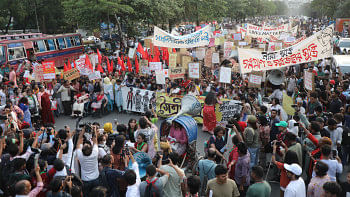Bangladeshis top Oman migrant population
Around seven lakh Bangladeshis working in Oman make up the largest migrant population in the gulf nation, outnumbering Indians, reported the Times of Oman yesterday.
The number of Bangladeshis stood at 6,94,449, Indians at 6,91,775 (now the second largest), and Pakistanis at 2,31,685 after the end of November this year, said the newspaper, quoting the National Centre for Statistics and Information (NCSI) of Oman.
Last November, there were 5,90,170 Bangladeshis and 6,69,882 Indians in Oman, while the numbers were respectively 4,96,761 and 6,00,349 in November 2013.
For decades, Indians have made up the bulk of migrant workers in the Sultanate, but despite police restrictions on the numbers of Bangladeshis allowed to enter Oman, as of November, their number has overtaken the number of Indian migrants.
A spokesman for Bangladesh Embassy in Muscat said Bangladeshis were preferred for major projects in the Sultanate while a spokesman for the Indian community said more Indians were choosing to stay at home as pay and working conditions in India were improving.
Of the seven lakh Bangladeshis, 1.85 lakh found jobs between January and December 20 this year, according to the Bureau of Manpower Employment and Training (BMET).
Last year, 1,29,859 Bangladeshis migrated to Oman for working in different sectors, especially for construction, says BMET.
Zahed Ahmad, counsellor at the labour wing of Bangladesh Embassy, told the Times of Oman that most Bangladeshis in the country were blue collar workers.
“The Omani sponsors are also very happy with the Bangladeshi workers, and this helps us employ more workers,” he added.
A large number of the Bangladeshis who come to Oman earn a salary of around OMR90 (US$ 233.64) to OMR100 (US$ 259.6) a month. “In this salary range, it is hard to hire people from other countries. It is one reason more Bangladeshis are coming to Oman,” Zahed said.
Mohammed Shafiqul Islam Bhuiyan, president of the Bangladesh Social Club in Oman, said most Bangladeshis worked in sectors like construction, agriculture, household, and restaurant.
“Efforts by the Bangladesh government to promote migration are adding to the Bangladeshi migrant workers' number in the Sultanate. Moreover, Oman now needs more manpower for a number of projects. As our people are capable of taking up the responsibility, they are being preferred,” he said.
The other main expat communities in Oman are Ethiopians, Indonesians, Filipinos, Egyptians, Nepalese, and Sri Lankans.

 For all latest news, follow The Daily Star's Google News channel.
For all latest news, follow The Daily Star's Google News channel. 



Comments